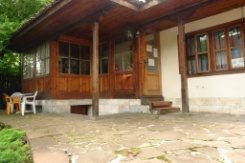

The exhibition “Family Obretenov” house museum “Zahari Stoyanov” was opened by the interest of Russian residents and visitors to this city known renascentisă family. In 1958, in Ruse, in the house of Nikola Obretenov son of Baba Tonka, it was developed and opened the museum “Baba Tonka”, where the visitor is familiar with the economic and political life of the end of the Russian era of Ottoman rule and the central place it is given the struggles of liberation. In the consciousness of most Bulgarians, named Baba Tonka link to struggle revival of spiritual liberation Bulgarian society and politics. An important contribution to this has and existing museum until 1992 that bore his name. As a result of the refund house of M. Obretenov house museum “Zahari Stoyanov” sheltered exhibition dedicated Obretenov Tonka road called life and his family, as national bulgaroaicei illustration of maturation and the role of the family and the residents of the Russian liberation struggles national.
The exhibition is arranged into four halls. One is a replica of Nikola Obretenov caninetului which was chronicler family and the Russian area in the years before 1878. He wrote “Memories of Bulgarian uprisings” left a rich correspondence with historians, literary historians, politicians , supporters, thanks to which the image can be restored Ottoman years.
The next room is devoted Obretenov family – it recounts the events that led to highlighting acesteo families who paid special attention to the role of Rakovski in revolutionary awakening the residents of Ruse. It was marked path each member nation’s Tiho (Tiho Obretenov husband called Baba Tonka was achieved and a model of family houses Obretenov arranged on high bank of the Danube. Emphasis was placed and preserved personal belongings.
Another room pays due attention to the phenomenon of the troop, as the battles of liberation and the most prominent supporters aiacesteia: P. Hitov, F. Totyu and, in particular, H. Dimitar St. Karadzha. Fog in the summer of 1868, led by the last two drivers, was widely portrayed, due to the fact that two of the sons of Baba Tonka participated in it. Petar died, and Angel was sentenced to exile forever. Stefan Karadzha was captured, taken to Russia and hanged (according to his memories Obretenov) ranks orăşeneşri halls today. In this room is exposed and sword revolver’s Karadzha.
In the fourth room was made to place Obretenov family participation in the next stages of development of the revolutionary movement. Russian occupied a network of committees when at the initiative of Angel Kanchev in the house called Baba Tonka, relied Committee of the Russian Rvoluţionar. Cap was his son, Nikola Obretenov and his associates: Thomas Kardzhiev Ilarion Dragostinov, Georgi Ikonomov, Radi Ivanov, Gancho Karamadzhakov. After the death of Levski lu, the Committee gradually began to become very important – twice, said he was “central” to the hinterland. Not coincidentally, the uprising in September 1875 was one of the most powerful events in the end of Ruse and family participation Obretenov to its preparation is illustrated by a copy of the flag sewn daughter, Petrana. April uprising, battles pinnacle of national eleiberare has taken a toll on the family – the youngest of children, George, died in Sliven Balkan and Nikola member of the troop Botev, was exiled. Petrana Obretenov participated in it as a hospital nurse in the Russian army from Svishtov. Emphasis was placed on the release of Ruse (20.02.1878г.) And the period after release from Obretenov family life.
House museum “Zahari Stoyanov” has opened its doors to visitors in March, 1978 as a result of împinirii the 100th anniversary of Bulgaria’s Liberation from Ottoman rule. Stoyanov was directly linked saccharin family Obretenov. Dzhendo’s spiritual growth in Rouschouk, his friendship with Nikola beneficial Obretenov, were decisive for the way he went later in life Curiosa medveneţ.
Considering the Russian his second birthplace, after the Liberation, Zahari Stoyanov was established to two the serpent here – 1878/1882. At 31.I.1882 he was married to the lesser of Baba Tonka children – Anastasia. In 1884, he appeared to Levski book, written with great affection and admiration for the Apostle personality. A year later, he printed the first tim of the largest of his works – “Notes on Bulgarian uprisings.” Follow “The caravans of Bulgaria …” and the book about the life and work of L. Karavelov.
With fiery words and enlightened journalism, Zahariy lights and prepare public opinion in Eastern Rumelia for the future unification of Bulgarian principality jueţelor – 09/06/1885. Thereafter, Z. Stoyanov is fixed for the third time in Ruse. In spring 1886, he ran as a representative of the people, deputy in the fourth ONS, he was elected Vice President and later as President of the National Assembly.
Zahari Stoyanov ended way early life – was 30 years old at 2.IX.1889 in the Parisian Hotel “Suez”. His remains were brought and buried in Ruse, a mormţnd built for this purpose. His bones were moved to the Pantheon of National Revival.
Z. Stoyanov’s marriage with A. Obretenov lived their only daughter – Zaharinka that bears his father’s name. It offered house built in 1898-1899 for the museum.
